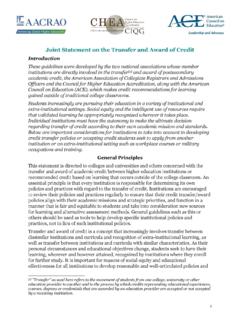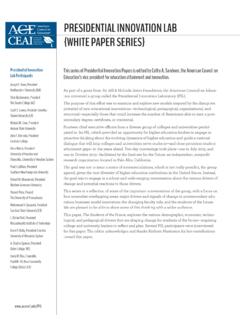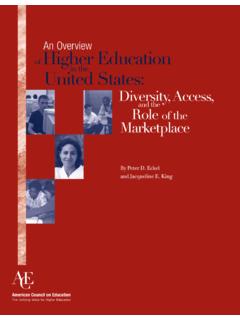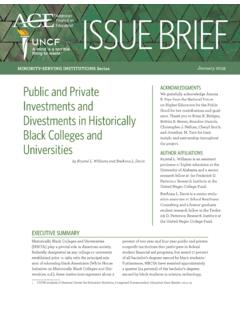Transcription of Shared Leadership in Higher Education
1 Viewpoints Viewpoints: Voices from the Field Voices from the Field Shared Leadership in Higher Education : Important Lessons from Research and Practice Adrianna J. Kezar University of Southern California & Elizabeth M. Holcombe University of Southern California Shared Leadership in Higher Education : Important Lessons from Research and Practice 1. ACE and the American Council on Education are registered marks of the American Council on Education and may not be used or reproduced without the express written permission of ACE.
2 American Council on Education One Dupont Circle NW. Washington, DC 20036. 2017. All rights reserved. No part of this publication may be reproduced or transmitted in any form or by any means electronic or mechanical , including photocopying, recording, or by any information storage and retrieval system, with- out permission in writing from the publisher. Shared Leadership in Higher Education : Important Lessons from Research and Practice Adrianna J. Kezar Professor for Higher Education and Co-Director, Pullias Center for Higher Education University of Southern California Elizabeth M.
3 Holcombe Research Associate, Pullias Center for Higher Education University of Southern California Suggested citation: Kezar, Adrianna J., and Elizabeth M. Holcombe. 2017. Shared Leadership in Higher Edu- cation: Important Lessons from Research and Practice. Washington, DC: American Council on Education . ACE's Center for Policy Research and Strategy (CPRS) provides thought lead- ership at the intersection of public policy and institutional strategy. The center provides senior college leaders and public policymakers with an evidence base to responsibly promote emergent practices in Higher Education with an emphasis on long-term and systemic solutions for an evolving Higher Education landscape and changing American demographic.
4 CPRS Viewpoints is a series of occasional, independent papers authored by leading social science researchers designed to explore new and emergent concepts or revisit foundational works in ways that help readers reframe or retool their thinking about Higher Education policy and practice. Viewpoints: Voices from the Field EXECUTIVE SUMMARY. Today's Higher Education Leadership challenges necessitate new forms of Leadership . A volatile financial environment, the rise of international partnerships, greater accountability pressures, the need for new busi- ness models, new technologies, and changing demographics are just some of these challenges, which call for Leadership solutions that are tested both inside and outside of Higher Education .
5 Shared Leadership consis- tently emerges as a key factor for organizations that were better able to learn, innovate, perform, and adapt to the types of external challenges that campuses now face. Shared Leadership is defined as moving away from the leader/follower binary; capitalizing on the importance of leaders throughout the organization, not just those in positions of authority; and creating an infrastruc- ture so that organizations can benefit from the Leadership of multiple people. Shared Leadership is different from Shared governance.
6 Shared governance is based on the principles of faculty and administration having distinct areas of delegated authority and decision making. Shared Leadership , by contrast, is more flexible and identifies various individuals on campus with relevant expertise. This allows multiple perspectives rather than those of a single decision-making body; for example, only faculty or administration. In order to reap the benefits of Shared Leadership , organizations should ensure that Shared Leadership structures and processes are authentic and thoughtfully designed.
7 Conditions that promote and sustain Shared Leadership include team empowerment, supportive vertical or hierarchical leaders, autonomy, Shared purpose or goal, external coaching, accountability structures, interdependence, fairness of rewards, and Shared cognition. Moreover, Leadership development in Higher Education as currently designed is ineffective for fostering Shared Leadership . Most Leadership development programs tend to focus on individuals who are already (or aspiring to be) in positions of authority. Few programs are designed to cultivate a broader num- ber of individuals or the structures to support Shared Leadership , although this is starting to change.
8 This report examines how a changing environmental context in Higher Education requires new Leadership skills and approaches, chief among them being the principles of Shared Leadership . We review the new Leadership environment, the research on Shared Leadership , and the small body of research in Higher educa- tion on Shared Leadership . We examine the significance of this research for Leadership development, discuss challenges to this approach, and offer implications for practice on college and university campuses. Shared Leadership in Higher Education : Important Lessons from Research and Practice v Viewpoints: Voices from the Field INTRODUCTION.
9 New models of Leadership recognize that effectiveness in knowledge based environments depends less on the heroic actions of a few individuals at the top and more on collaborative Leadership prac- tices distributed throughout an organization suggesting that a more dynamic relational concept of Leadership has emerged. (Pearce and Conger 2003, cited by Fletcher 2004, 648). The above quote captures how today's complex environments require new forms of collaborative or Shared Leadership to help campuses become nimbler and responsive to needed changes.
10 Higher Education leaders now face a very different set of challenges that necessitate new forms of Leadership : for example, a volatile financial environment, the rise of global and international partnerships, greater accountability pressures around college completion and learning outcomes, the need for new business models, opportunities for innovation with technology, and changing demographics (Wallin 2010). While Higher Education has under- gone periods of significant change in the enterprise, particularly after World War II when enrollments grew significantly, today's environment is unique in terms of the sheer number of areas that demand change.













